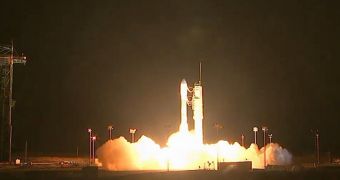Officials at the American space agency announce that their newest weather satellite launched successfully earlier today, October 28, from the Vandenberg Air Force Base, in California. Takeoff occurred at 5:48 am EDT (0948 GMT).
The vehicle is called the National Polar-orbiting Operational Environmental Satellite System (NPOESS) Preparatory Project (NPP), and represents one of the most advanced Earth-observing spacecraft ever constructed and deployed.
Originally, it was supposed to be a test vehicle for the NPOESS satellite constellation, but that project was canceled last year. In February 2010, the mission was separated into two different projects, one controlled by the US National Oceanic and Atmospheric Administration (NOAA) and the other by the Department of Defense.
The NOAA segment is called the Joint Polar Satellite System (JPSS), and is scheduled to see its first satellite – the JPSS-1 spacecraft – put in orbit by February 1, 2015. Ball Aerospace & Technologies Corporation received the $248 (€175.3) million contract for constructing the vehicle.
The DoD will control the Defense Weather Satellite System (DWSS), which will primarily be used for national security applications that will not be disclosed to the media, Space reports.
Rather than assigning NPP to any of these projects, NASA decided to launch the spacecraft as a stand-alone, Earth-monitoring mission. The instruments aboard the satellite will enable climate scientists to assess our planet's long-term climate variations in exquisite detail.
In addition, the datasets will help meteorologists make short-term weather forecasts with increased degrees of certainty. The NPP was launched to space aboard a Delta II delivery system, which was built by the United Launch Alliance (ULA).
“Liftoff of the Delta 2 with the NPP satellite, blazing the way in new technology for climate research and weather forecasting,” NASA launch announcer George Diller said as the rocket achieved liftoff.
“We know it'll become a significant part of our nation's climate and weather monitoring system,” NASA Headquarters NPP program executive Andrew Carson told the media a couple of days ago.
The NPP tips the scale at around 4,500 pounds (2,041 kilograms), and took $1.5 billion to build. The spacecraft was developed to tread in the footsteps of established Earth-monitoring missions such as the NASA Terra, Aqua and Aura satellites.

 14 DAY TRIAL //
14 DAY TRIAL //